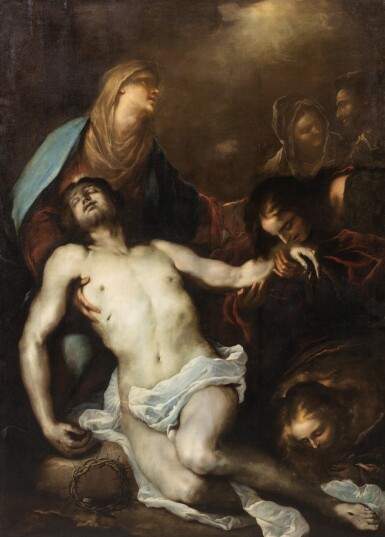
L'œil et l'histoire: paintings from a french private collection (lots 23, 24, 65, 66 and 139, 140, 149, 152, 153, 154, 197)
Luca Giordano
The Lamentation of Christ
Auction Closed
June 15, 02:40 PM GMT
Estimate
30,000 - 50,000 EUR
Lot Details
Description
L'œil et l'histoire: paintings from a french private collection (lots 23, 24, 65, 66 and 139, 140, 149, 152, 153, 154, 197)
Luca Giordano
Naples 1634 - 1705
The Lamentation of Christ
Oil on canvas
202,3 x 146 cm ; 79⅝ by 57½ in.
__________________________________________________________________________
L'œil et l'histoire : tableaux d'une collection privée française (lots 23, 24, 65, 66 et 139, 140, 149, 152, 153, 154, 197
Luca Giordano
Naples 1634 - 1705
Lamentation sur le Christ mort
Huile sur toile
202,3 x 146 cm ; 79⅝ by 57½ in.
Docteur C. Collection;
His sale, Paris, Hôtel Drouot, 16 March 1976, lot 58 (as Studio of Jan van Dyck);
Where acquired by the present owner.
__________________________________________________________________________
Collection du Docteur C. ;
Sa vente, Paris, Hôtel Drouot, 16 mars 1976, lot 58 (comme Atelier de Jan van Dyck) ;
Où acquis par l'actuel propriétaire.
The seventeenth century Neapolitan painter Luca Giordano, who trained in Ribera's workshop (1591-1652), is acknowledged as one of the greatest masters of Baroque art. His travels in Italy and later in Spain introduced him to the work of other schools; the Venetian painters were in particular a formative influence on the artist. He absorbed the lessons of Titian (1488/1490-1576), Tintoretto (circa 1518-1594) and Veronese (1528-1588) with enthusiasm, exploring all the possibilities of his palette and skilfully experimenting with contrasts.
Lamentation over the Dead Christ is an important rediscovery to add to Giordano's corpus. This unpublished work, which can be dated to the artist's youth, is particularly striking for both the sombre nature of the subject matter and its treatment. The free brushstroke and the touches of impasto accentuate textures, drapery and flesh, while the contrast between Christ's deathly pale body and the other figures, plunged into darkness, reinforces the dramatic tension. The Virgin supports her son's body, her eyes turned imploringly to the heavens. St John, on the right, leans over Christ's left arm, which he holds in both hands, in a gesture expressing his desolation. Mary Magdalene, her face emerging from the darkness in the lower right-hand corner, bends to kiss Christ's feet.
Giordano was a prolific artist, who continually adapted his style according to the period, place and commission, but was always attached to devotional images. In his youth, he was strongly influenced by Ribera and Tenebrism, especially in his images of martyrs and the Passion of Christ. In the 1660s, Luca Giordano's production also reflected the artist's personal experience, reflecting the plague that swept through Naples in 1656 amid daily incidents of violence. This period left him with a pragmatic eye for the brutality and injustice of death, expressed poignantly in this Lamentation over the Dead Christ.
We are grateful to Pr. Nicola Spinosa who confirmed the authentication of this painting, based on photographs. He dates this unpublished version circa 1653-1654.
__________________________________________________________________________
Peintre napolitain du XVIIe siècle, formé au sein de l'atelier de Ribera (1591-1652), Luca Giordano s'est imposé comme l'un des plus grands maîtres de l'art baroque. Ses voyages en Italie, puis en Espagne, le familiarisent avec la peinture d'autres écoles ; les peintres vénitiens, plus particulièrement, seront une influence déterminante pour l'artiste. Il assimile avec brio les leçons de Titien (1488/1490-1576), Tintoret (vers 1518-1594) et Véronèse (1528-1588), explorant toutes les possibilités de sa palette et jouant habilement avec les contrastes.
La Lamentation sur le Christ mort est une redécouverte importante au sein du corpus de Giordano. Cette œuvre inédite, que nous pouvons dater de la jeunesse de l’artiste, est particulièrement saisissante, tant par la gravité du sujet que dans son traitement. La touche libérée et les empâtements soulignent les textures, les tissus et les chairs, tandis que le contraste entre le corps livide du Christ et les autres figures, plongées dans l’obscurité, vient renforcer la tension dramatique. La Vierge retient le corps de son fils et lance un regard implorant vers le ciel. Saint Jean apparaît sur la droite, tenant de ses deux mains le bras gauche du Christ, vers lequel il penche son visage, dans un geste affligé. Marie Madeleine, dont le visage en bas à droite émerge de la pénombre, s’apprête à embrasser les pieds du Christ.
Artiste prolifique, qui adapta constamment son style en fonction de l’époque, du lieu et du commanditaire, Giordano demeura toujours attaché aux images de dévotion. Dans sa jeunesse, il est fortement influencé par Ribera et le ténébrisme, notamment dans ses représentations de martyres et de la Passion du Christ. Dans les années 1660, les œuvres de Luca Giordano reflètent également l’expérience personnel du peintre, témoin de la peste qui frappe la ville de Naples en 1656 et des violences qui sont quotidiennes. De cette période, il gardera un regard pragmatique sur la brutalité et l’injustice de la mort, qu’il traduit de manière poignante dans sa Lamentation sur le Christ mort.
Nous remercions le Professeur Nicola Spinosa d'avoir confirmé l'authenticité de cette œuvre, d'après photographies. Il date ce tableau inédit des années 1653-1654.
You May Also Like










